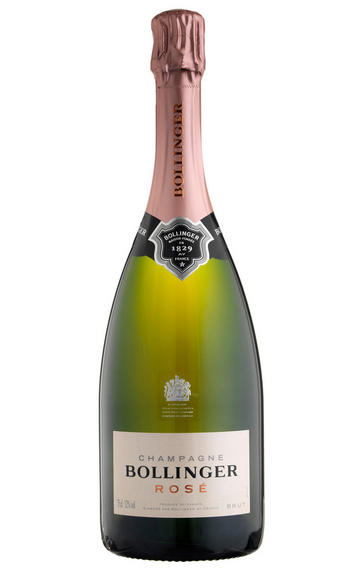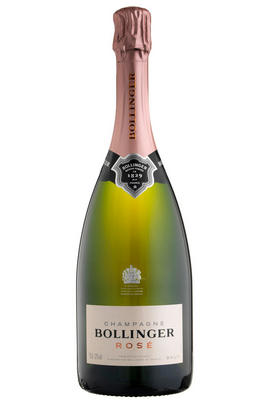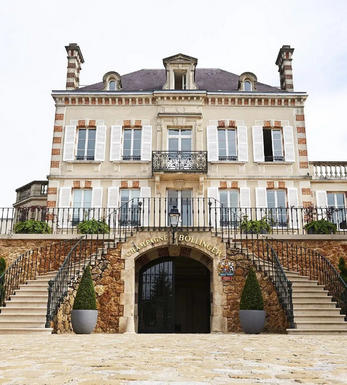
2005 Champagne Bollinger, La Grande Année, Rosé, Brut

Critics reviews
The nose leads with bright, pristine, strawberry notes and a buoyant palate follows hot on its heels. The texture is very smooth, silky and ethereal and it seems forward and flattering already. Having said this it will still manage to age well such is the tension on the finish. There is a touch of the honey that I also spotted in the ’05 LGA white – which serves to make its precocity even more pronounced. Interestingly, no La Côtes Aux Enfants red was made in this vintage because they needed all of it for their rosé.
Matthew Jukes - matthewjukes.com - April 2015
About this WINE

Bollinger
The Champagne House of Bollinger was established in 1829 by Jacques Bollinger and Paul Renaudin. Over the years the vineyard holdings have been steadily increased with the largest expansion taking place under the stewardship of the legendary Mme Lily Bollinger. She ran the company between 1941 and 1977 and today it is managed by her great-nephew, Ghislain de Montgolfier.
Bollinger has a reputation for producing muscular champagnes with body, depth and power, and is today considered one of the "Great" Champagne houses.
70% of the grapes come from the firm's own vineyards. 80% of the harvest is barrel-fermented with the wines being kept on their yeast lees for an extended period of time (in the case of the RD, around 10 years).
Bollinger produces classic, complex, Pinot-Noir dominated champagnes with the ability to age gracefully for many years.

Rosé Champagne
Rosé wines are produced by leaving the juice of red grapes to macerate on their skins for a brief time to extract pigments (natural colourings). However, Rosé Champagne is notable in that it is produced by the addition of a small percentage of red wine – usually Pinot Noir from the village of Bouzy – during blending.
Recommended Producers : Billecart Salmon (Elizabeth Salmon Rose), Ruinart

Champagne blend
Which grapes are included in the blend, and their proportion, is one of the key factors determining the style of most Champagnes. Three grapes are used - Pinot Noir, Chardonnay and Pinot Meunier.
26% of vineyards in Champagne are planted with Chardonnay and it performs best on the Côtes des Blancs and on the chalk slopes south of Epernay. It is relatively simple to grow, although it buds early and thus is susceptible to spring frosts. It produces lighter, fresher wines than those from Burgundy and gives finesse, fruit and elegance to the final blend. It is the sole grape in Blancs de Blancs, which are some of the richest long-lived Champagnes produced.
Pinot Noir accounts for nearly 40% of the plantings in Champagne and lies at the heart of most blends - it gives Champagne its body, structure, strength and grip. It is planted across Champagne and particularly so in the southern Aube district.
The final component is Pinot Meunier and this constitutes nearly 35% of the plantings. Its durability and resistance to spring frosts make the Marne Valley, a notorious frost pocket, its natural home. It ripens well in poor years and produces a soft, fruity style of wine that is ideal for blending with the more assertive flavours of Pinot Noir. Producers allege that Pinot Meunier lacks ageing potential, but this does not deter Krug from including around 15% of it in their final blends.


Buying options
Add to wishlist
Description
Rare and infinitely subtle, La Grande Année Rosé is a blend of 72 percent Pinot Noir and 28 percent Chardonnay, almost all from Grand Cru vineyards, with the Pinot element including five percent of red wine added from the famous Bollinger vineyard of La Côte aux Enfants. Over six years of maturation on natural cork has been complemented by seven grams of sugar added by way of dosage and then further post-disgorgement slumber to ensure a perfectly harmonious equilibrium.
This is evidenced by a gentle onion-skin colour, a nose of brioche, ginger and mandarin and a palate which combines expressive red fruit with a perfectly creamy and yet citric counterpoint, courtesy of the Chardonnay. The texture is lacy yet complete, ethereal and magnificently satisfying.
wine at a glance
Delivery and quality guarantee